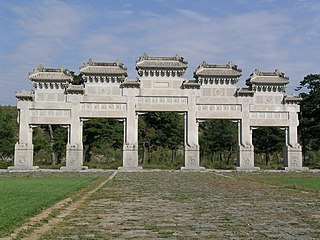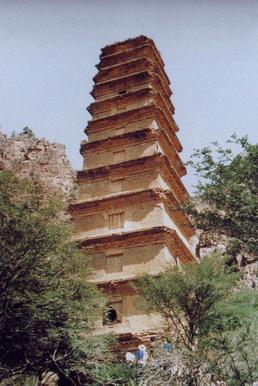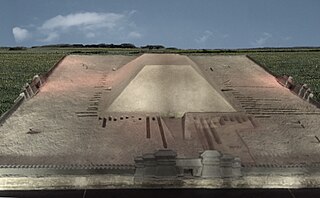
The Tangut people were a Sino-Tibetan people that founded and inhabited the Western Xia dynasty. The group initially lived under Tuyuhun authority, but later submitted to the Tang dynasty. After the collapse of Tang dynasty, the Tanguts established the Western Xia. They spoke the Tangut language, which was previously believed to be one of the Qiangic languages or Yi languages which belong to the Tibeto-Burman family." Phylogenetic and historical linguistic accounts, however, reveal that Tangut belonged instead to the Gyalrongic branch of Tibeto-Burman. Western Xia was annihilated by the Mongol Empire in 1227, most of its written records and architecture were destroyed. Today the Tangut language and its unique script are extinct, only fragments of Tangut literature remain.

Ningxia, officially the Ningxia Hui Autonomous Region, is an autonomous region in the northwest of the People's Republic of China. Formerly a province, Ningxia was incorporated into Gansu in 1954 but was later separated from Gansu in 1958 and reconstituted as an autonomous region for the Hui people, one of the 56 officially recognised nationalities of China. Twenty percent of China's Hui population lives in Ningxia.

Yinchuan is the capital of the Ningxia Hui Autonomous Region, China, and was the capital of the Tangut-led Western Xia dynasty. It has an area of 8,874.61 km2 (3,426.51 sq mi) and a total population of 2,859,074 according to the 2020 Chinese census, and its built-up area was home to 2,564,918 inhabitants spread between three urban districts and Helan and Yongning counties largely being urbanized. The city's name literally means "silver river".

The term Chinese pyramids refers to pyramidal shaped structures in China, most of which are ancient mausoleums and burial mounds built to house the remains of several early emperors of China and their imperial relatives. About 38 of them are located around 25 kilometres (16 mi) – 35 kilometres (22 mi) north-west of Xi'an, on the Guanzhong Plains in Shaanxi Province. The most famous is the Mausoleum of the First Qin Emperor, northeast of Xi'an and 1.7 km west of where the Terracotta Army was found.
Imperial Tombs of the Ming and Qing Dynasties is the designation under which the UNESCO has included several tombs and burial complexes in the list of World Heritage Sites. These tombs date from the Ming and Qing dynasties of China.
Emperor Huanzong of Western Xia (1177–1206), born Li Chunyou, was the sixth emperor of the Western Xia dynasty of China, reigning from 1193 to 1206.

Lingwu is a county-level city of Ningxia Hui Autonomous Region, Southwest China, it is under the administration of the prefecture-level city of Yinchuan. It is the most important industrial city of Ningxia. Lingwu spans an area of 3,846 square kilometres (1,485 sq mi), and according to the 2010 Chinese census, Lingwu has a population of 261,677.

Zeng is a Chinese family name. In Cantonese, it is Tsang; In Wade–Giles, such as those in Taiwan, Tseng or Tzeng; in Malaysia and Singapore, Tsen, Chen or Cheng; in the Philippines, Chan; in Indonesia, Tjan; in Vietnam, Tăng. The surname Zeng is the 32nd most common surname in Mainland China as of 2019. It is the 16th most common surname in Taiwan. It meant "high" or "add" in ancient Chinese.

The Western Xia mausoleums occupy an area of some 50 km2 (19 sq mi) at the foot of the Helan Mountains in the Ningxia Hui Autonomous Region of northwestern China, and include nine imperial mausoleums and 250 tombs of imperial relatives and officials of China's Western Xia dynasty. This burial complex lies some 40 km (25 mi) westward from capital city of the Western Xia, the Xingqing fu or Xingqing, what is modern-day Yinchuan, capital of the Ningxia Hui Autonomous Region.

The Western Qing tombs are located some 140 km (87 mi) southwest of Beijing in Yi County, Hebei Province. They constitute a necropolis that incorporates four royal mausoleums where seventy-eight royal members are buried. These include four emperors of the Qing dynasty and their empresses, imperial concubines, princes and princesses, as well as other royal servants.

The Eastern Qing tombs are an imperial mausoleum complex of the Qing dynasty located in Zunhua, 125 kilometres (78 mi) northeast of Beijing. They are the largest, most complete, and best preserved extant mausoleum complex in China. Altogether, five emperors, 15 empresses, 136 imperial concubines, three princes, and two princesses of the Qing dynasty are buried here. Surrounded by Changrui Mountain, Jinxing Mountain, Huanghua Mountain, and Yingfei Daoyang Mountain, the tomb complex stretches over a total area of 80 square kilometres (31 sq mi).
Cui Sun (崔損), courtesy name Zhiwu (至無), was an official of the Chinese Tang Dynasty, serving as a chancellor during the reign of Emperor Dezong.
Li Fanwen is a Chinese linguist and Tangutologist.

Baisigou Square Pagoda was a brick pagoda in Helan County, Ningxia, China, built during the early years of the Western Xia dynasty (1038–1227), circa 1075–1076. It is situated in an isolated location about 10 km into the Baisigou Valley on the eastern side of the Helan Mountains, northwest of Yinchuan, but may have been the site of an important Buddhist temple during the Western Xia. The pagoda was illegally destroyed in 1990; archaeological investigation of the ruins has uncovered a large number of Tangut artefacts and Buddhist relics, including books and manuscripts written in the Tangut language and script.

The Yangling Mausoleum of Han is the mausoleum of Emperor Jing, the sixth emperor of the Western Han dynasty and his Empress Wang. The mausoleum complex is a part of the Western Han dynasty imperial tombs located in the Weicheng district of the City of Xianyang, Shaanxi Province, on the northern bank of the Wei River and about 20 km to the north of the city center of the provincial capital of Xi’an.

The Mongol conquest of Western Xia was a series of conflicts between the Mongol Empire and the Tangut-led Western Xia dynasty in northwestern China. Hoping to gain both plunder and a vassal state, the Mongol leader Genghis Khan commanded some initial raids against Western Xia before launching a full-scale invasion in 1209. This marked both the first major invasion conducted by Genghis and the first major Mongol invasion of China.

The Pagoda of Chengtian Temple, meaning 'Bearing Heaven Pagoda', is an eleven-storeyed brick pagoda located on the site of a previous Buddhist temple in Yinchuan city, Ningxia, China. The pagoda was originally built during the Western Xia, but the current structure dates to the Qing dynasty. At 64.5 metres (212 ft) in height it is the tallest pagoda in Ningxia. In contrast to the Haibao Pagoda in Yinchuan, which is known as the Northern Pagoda, Chengtian Temple Pagoda is also informally referred to as the Western Pagoda.

The Haibao Pagoda Temple is a Buddhist temple located in Xingqing District of Yinchuan, Ningxia, China. Because of earthquakes, the modern temple was founded in the 18th century in the period of the Qianlong Emperor (1736–1796) during the mid-Qing dynasty (1644–1911). It is the headquarters of the Buddhist Association of Ningxia.

Li Xian was a Northern Zhou general and Governor of Dunhuang. He was born in 502 CE in Guyuan, at the time under Northern Wei rule. As a soldier, he served the three dynasties of the Northern Wei, Western Wei, and Northern Zhou. Emperor Yuwen Tai entrusted him with the education of two of his sons during 6 years, as the imperial court had become too dangerous, and one of them, Yuwen Yong, would become Emperor Wu of Northern Zhou. Li Xian was in charge of defenses on the northern frontier of the Chinese Empire, in contact with the Silk Road. He died in Changan at the age of 66, in 569 CE. He was important enough to be mentioned in the Zhoushu and the Beishi. He was the great-grandfather of the famous Sui dynasty princess Li Jingxun.














